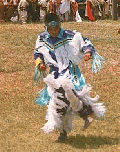| The Grass Dance style is a very old dance rich in history that has become very popular. In
the old days, it was the job of the grass dancers to flatten the grass in the arena before a
pow wow. The name "grass" does not come from the stomping of grass, but it comes from
the old habit of tying braids of sweetgrass to the dancer's belts, producing a swaying effect.
Today, Grass Dancers resemble a multicolored swaying mass of yarn or fringe on the dance
floor. The Grass Dance is a very fluid and bendable style, with the dancers trying to move
their fringe in as many places as possible at once. The Grass Dance style was born in the
North, but its popularity has spread South, and now this beautiful style is availible for
everyone. |















 Since 11/11/99
Since 11/11/99